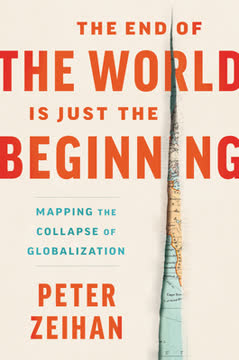Key Takeaways
1. China's economic miracle is built on an unsustainable foundation of debt and waste
"Trees don't grow to the sky," he wrote. "If we don't control things it could trigger a systemic financial crisis, leading to an economic recession, and all the hopes stored up by the people will be dashed to pieces."
Debt-fueled growth. China's rapid economic expansion has been largely driven by massive debt accumulation and wasteful investments. Since 2008, China has added about $12 trillion in debt, roughly the size of the entire U.S. banking system at that time. This unprecedented credit expansion has led to:
- Overcapacity in industries like steel, cement, and shipbuilding
- Ghost cities with empty apartment buildings and unused infrastructure
- Inefficient allocation of resources to unproductive sectors
Mounting risks. As debt levels continue to rise faster than economic growth, the risks of a financial crisis or prolonged economic stagnation increase. Key concerns include:
- Local government debt reaching unsustainable levels
- Rising corporate debt, particularly among state-owned enterprises
- Growing shadow banking sector operating outside traditional regulatory frameworks
2. Ghost cities and overinvestment in infrastructure reflect local government incentives
"This is a recurring theme in Chinese political attitudes," Dickson writes. "The higher their income, the more highly they evaluate the status quo, and the more highly they are satisfied with it."
Perverse incentives. Local government officials are incentivized to prioritize short-term GDP growth and tax revenue over long-term economic sustainability. This leads to:
- Massive construction projects to boost local economies
- Overbuilding of housing, office space, and infrastructure
- Land expropriation from farmers to fuel urban expansion
Consequences of overinvestment. The results of these misaligned incentives include:
- Ghost cities with low occupancy rates
- Underutilized infrastructure projects
- Inefficient allocation of capital and resources
- Growing local government debt burdens
3. Land sales fuel China's growth but create long-term economic risks
"The political leadership of China never ceases to assure us that further opening towards foreign investment, a level playing field between German and Chinese companies, as well as protection of intellectual property is a priority," Ambassador Clauss wrote in his 2017 column. "However, many companies keep telling us that their difficulties in these areas have increased. It often appears that somewhere down the line, political assurances of equal treatment give way to protectionist tendencies."
Land-driven growth model. Local governments in China heavily rely on land sales to generate revenue and fuel economic growth. This system:
- Allows for rapid urbanization and infrastructure development
- Provides a significant source of local government funding
- Creates incentives for continued expansion and construction
Long-term risks. The dependence on land sales creates several potential problems:
- Unsustainable urban expansion and environmental degradation
- Displaced farmers and social unrest
- Inflated property values and potential real estate bubbles
- Overreliance on construction and real estate for economic growth
4. The banking system and shadow banking enable unsustainable credit expansion
"It is now more difficult to remove hidden barriers and break vested interests when tackling the hard problems in reform," the state planning agency said in its annual report to parliament in 2015. "Deepening reform will involve more complicated conflicts and affect more deep rooted interests."
Shadow banking growth. China's shadow banking sector has expanded rapidly, allowing for continued credit growth outside traditional regulatory frameworks. Key features include:
- Wealth management products (WMPs) offered by banks
- Trust companies and other non-bank financial institutions
- Complex financial instruments that obscure risk
Systemic risks. The growth of shadow banking creates potential vulnerabilities:
- Lack of transparency and difficulty in assessing true risk levels
- Interconnectedness between traditional banks and shadow banking entities
- Potential for rapid credit contraction if confidence in the system falters
5. Vested interests and resistance to reform hinder necessary economic changes
"SOEs [state-owned enterprises] are becoming special interest groups with a strong resistance to reform," He Fan, one of China's most respected economists and the deputy director of the Research Center for International Finance at the Chinese Academy of Social Sciences, wrote in 2015. "Some are more like independent kingdoms in their own industries."
Entrenched interests. Powerful groups within China's economy resist reforms that could threaten their privileged positions:
- State-owned enterprises (SOEs) benefiting from government support and protection
- Local government officials whose career prospects depend on continued growth
- Bureaucrats and party members profiting from the current system
Reform challenges. Overcoming resistance to change is a significant obstacle:
- Difficulty in implementing market-oriented reforms
- Persistence of inefficient industries and companies
- Continued misallocation of resources and capital
6. China's aging population and rising costs threaten its economic model
"In the next five to ten years, the chance of China sliding into the middle-income trap is extremely high. I put the odds at 50–50," Lou said in a speech to Tsinghua University students in mid-2015. "Why? . . . Because society is aging and the working-age population is shrinking too fast."
Demographic challenges. China's rapidly aging population poses significant economic risks:
- Shrinking working-age population (projected to fall by 45 million between 2015-2030)
- Increasing burden on social services and healthcare systems
- Potential for slower economic growth as workforce declines
Rising costs. China's traditional low-cost manufacturing model is under pressure:
- Wages rising faster than productivity gains
- Increasing land and energy costs
- Growing environmental regulations and cleanup costs
7. The government's response to economic challenges may shape China's future trajectory
Lou argued that the solution—to the extent that there was one—was to raise the efficiency of the economy through free-market reform. As long as China was cheap, there wasn't any need to be efficient, resulting in a huge amount of waste.
Policy dilemma. Chinese leaders face difficult choices in addressing economic challenges:
- Balancing need for reform with maintaining social stability
- Managing debt levels without causing a sharp economic slowdown
- Transitioning to a more sustainable economic model while preserving growth
Potential outcomes. The government's response could lead to various scenarios:
- Successful economic rebalancing and transition to higher-value industries
- Prolonged period of slower growth (similar to Japan's "Lost Decade")
- Financial crisis if systemic risks are not adequately addressed
- Political instability if economic problems lead to widespread discontent
Last updated:
FAQ
What's China's Great Wall of Debt about?
- Focus on China's economy: The book delves into the complexities of China's economic growth, emphasizing the role of debt in sustaining this growth. It examines how local governments and state-owned enterprises have heavily relied on borrowing for infrastructure and development projects.
- Debt as a central theme: Dinny McMahon argues that the rapid accumulation of debt poses significant risks to both the Chinese economy and the global financial system. He suggests that this debt-driven growth model is unsustainable.
- Consequences of overexpansion: The book discusses phenomena like "ghost cities" and "zombie companies," highlighting the disconnect between construction and actual demand, and illustrating broader issues of resource misallocation and economic inefficiencies.
Why should I read China's Great Wall of Debt?
- Insight into economic dynamics: The book provides a detailed analysis of China's economic model, making it essential for anyone interested in global economics. It offers a unique perspective on the interplay between state control and market forces.
- Understanding global implications: As China is poised to become the world's largest economy, understanding its financial challenges is crucial for global stability. The book helps readers grasp the potential risks arising from China's economic policies.
- Engaging narrative: McMahon combines personal anecdotes with rigorous analysis, making complex economic concepts accessible and engaging. His experiences as a financial journalist in China add depth to the narrative.
What are the key takeaways of China's Great Wall of Debt?
- Unsustainable growth model: The book argues that China's reliance on debt for growth is a ticking time bomb, warning that this model could lead to a financial crisis with global repercussions.
- Role of local governments: Local governments drive economic growth through infrastructure projects funded by debt, leading to overcapacity and financial strain on local authorities.
- Shadow banking system: The emergence of shadow banking has allowed for rapid credit expansion, complicating the financial landscape and posing significant risks.
What are the best quotes from China's Great Wall of Debt and what do they mean?
- "The miracle is over.": This quote encapsulates the central thesis, indicating that China's rapid growth is no longer sustainable due to excessive debt, serving as a warning about potential economic instability.
- "Trading space for time.": This phrase describes the Chinese government's strategy of delaying necessary reforms to maintain growth, highlighting the precarious balance between short-term stability and long-term sustainability.
- "Land is the lifeblood of China’s masses.": This quote emphasizes the importance of land ownership and agricultural rights for rural communities, underscoring social tensions from land expropriations for urban development.
How does China's Great Wall of Debt explain the concept of "ghost cities"?
- Definition of ghost cities: Ghost cities are urban developments that have been built but remain largely uninhabited, constructed by local governments in anticipation of future migration that often does not materialize.
- Economic implications: The existence of ghost cities reflects the misallocation of resources and the disconnect between construction and actual demand, contributing to the overall debt burden on local governments.
- Policy critique: McMahon critiques policies that encourage rapid urbanization without considering economic viability, arguing that this approach leads to waste and financial instability.
What are "zombie companies" as described in China's Great Wall of Debt?
- Definition of zombie companies: Zombie companies are firms unable to generate enough revenue to cover their debt obligations but are kept alive through continued borrowing, draining resources from the economy.
- Impact on the economy: The prevalence of zombie companies indicates systemic inefficiencies within China's economic model, contributing to overcapacity and hindering the growth of more productive enterprises.
- Government intervention: Local governments often support these companies to maintain employment and social stability, creating a cycle of dependency that exacerbates financial risks.
How does China's Great Wall of Debt address the issue of local government debt?
- Local government financing: The book details how local governments rely on land sales and borrowing to fund infrastructure projects, leading to significant debt accumulation threatening financial stability.
- Consequences of debt: McMahon highlights risks associated with local government debt, including potential defaults and impacts on public services, often hidden from view, complicating financial health assessments.
- Call for reform: The author advocates for reevaluating the current financing model to ensure sustainable growth, emphasizing the need for greater transparency and accountability in local government borrowing.
What role does shadow banking play in China's economy according to China's Great Wall of Debt?
- Definition of shadow banking: Shadow banking refers to financial activities outside traditional banking regulations, including peer-to-peer lending and wealth management products, which have grown rapidly in China.
- Risks of shadow banking: The book discusses dangers posed by shadow banking, including potential financial instability and lack of oversight, warning that this unregulated environment could lead to widespread defaults.
- Impact on credit availability: Shadow banking has increased credit availability, particularly for private companies struggling to secure traditional bank loans, contributing to the overall debt burden.
How does China's Great Wall of Debt illustrate the relationship between debt and economic growth?
- Debt as a growth driver: McMahon argues that debt has been a primary driver of China's economic growth, enabling rapid infrastructure development and urbanization, but creating significant vulnerabilities.
- Unsustainable growth: The book emphasizes that the current growth model is unsustainable, as debt accumulation outpaces economic growth, potentially leading to a financial crisis with global implications.
- Need for reform: The author calls for a shift in economic policy to prioritize sustainable growth over short-term gains, advocating for structural reforms addressing underlying debt and inefficiency issues.
What are the potential consequences of China's economic model as discussed in China's Great Wall of Debt?
- Risk of financial crisis: McMahon warns that excessive debt accumulation could lead to a financial crisis with far-reaching global effects, highlighting interconnected financial systems and potential contagion.
- Social unrest: Economic instability could lead to social unrest, particularly in rural areas where land expropriations have caused discontent, emphasizing the importance of addressing grievances for social stability.
- Global economic implications: As China grows, potential economic instability poses risks not only to China but to the global economy, making understanding these dynamics crucial for policymakers worldwide.
How does China's Great Wall of Debt address the issue of income inequality in China?
- Growing disparity: The book points out that income inequality in China has reached alarming levels, with a significant gap between the wealthy elite and the average citizen, posing risks to social stability and economic growth.
- Impact on social contract: McMahon argues that the social contract between the Chinese Communist Party and its citizens is based on rising incomes and improved living standards, which could be threatened if economic growth stagnates.
- Political implications: Rising inequality could lead to increased social unrest and pressure on the government to implement reforms, making addressing income inequality crucial for maintaining social harmony and political stability.
What solutions does China's Great Wall of Debt propose for addressing China's economic challenges?
- Need for reform: The book advocates for significant economic reforms to transition from a debt-driven growth model to one prioritizing consumption and innovation, addressing income inequality and improving citizens' quality of life.
- Regulation of financial institutions: McMahon suggests better regulation of financial institutions, particularly shadow banks, to mitigate risks and ensure financial system stability, involving increased transparency and accountability.
- Focus on sustainable development: The author emphasizes sustainable development practices prioritizing long-term economic health over short-term gains, rethinking urban planning and construction to avoid ghost cities and overcapacity pitfalls.
Review Summary
China's Great Wall of Debt offers an insider's perspective on China's complex economy, examining debt-fueled growth, shadow banking, and ghost cities. While acknowledging China's economic achievements, the book highlights potential risks and challenges. Readers appreciate McMahon's balanced approach, accessible writing, and use of anecdotes to illustrate complex issues. Some criticize the lack of deeper analysis or data, while others praise the book's insights into China's financial system and its implications for the global economy. Overall, it's considered a valuable read for understanding modern China's economic landscape.
Similar Books








Download PDF
Download EPUB
.epub digital book format is ideal for reading ebooks on phones, tablets, and e-readers.




